经济专业技术资格《经济基础知识》考试试题.doc
- 格式:doc
- 大小:86.50 KB
- 文档页数:24
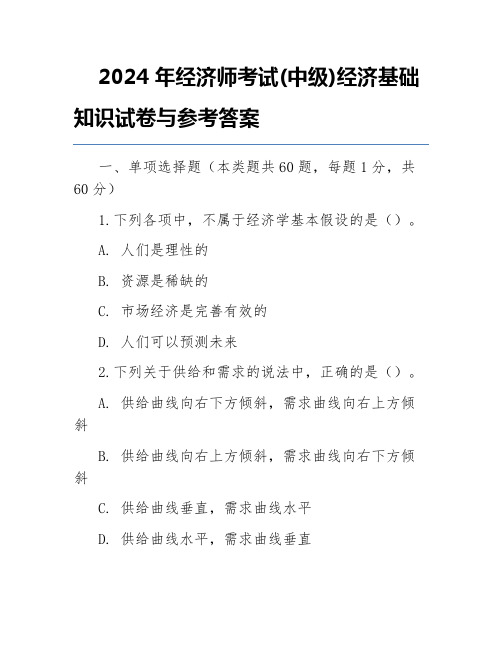
2024年经济师考试(中级)经济基础知识试卷与参考答案一、单项选择题(本类题共60题,每题1分,共60分)1.下列各项中,不属于经济学基本假设的是()。
A. 人们是理性的B. 资源是稀缺的C. 市场经济是完善有效的D. 人们可以预测未来2.下列关于供给和需求的说法中,正确的是()。
A. 供给曲线向右下方倾斜,需求曲线向右上方倾斜B. 供给曲线向右上方倾斜,需求曲线向右下方倾斜C. 供给曲线垂直,需求曲线水平D. 供给曲线水平,需求曲线垂直3.某商品的供给曲线为P=10+2Q,其中P为价格,Q 为数量。
若生产该商品的成本下降,下列说法正确的是()。
A. 供给曲线不变B. 供给曲线向右下方移动C. 供给曲线向右上方移动D. 供给曲线垂直移动4.某商品的需求曲线为Q=10-P,其中P为价格,Q为数量。
若消费者的收入增加,下列说法正确的是()。
A. 需求曲线不变B. 需求曲线向右下方移动C. 需求曲线向右上方移动D. 需求曲线垂直移动5.下列关于市场均衡的说法中,正确的是()。
A. 市场均衡时,供给等于需求B. 市场均衡时,供给大于需求C. 市场均衡时,供给小于需求D. 市场均衡时,供给和需求无关6.下列关于完全竞争市场的说法中,正确的是()。
A. 市场中有很多生产者和消费者B. 商品同质无差异C. 生产者可以控制价格D. 市场信息不对称7.下列关于垄断市场的说法中,正确的是()。
A. 市场中只有一个生产者B. 商品同质无差异C. 生产者不能控制价格D. 市场信息完全透明8.下列关于寡头垄断市场的说法中,正确的是()。
A. 市场中只有两个生产者B. 商品同质无差异C. 生产者可以控制价格D. 市场信息完全透明9.下列关于混合市场的说法中,正确的是()。
A. 市场中有很多生产者和消费者B. 商品同质无差异C. 生产者可以控制价格D. 市场信息不对称10.下列关于宏观经济的总量调控政策的说法中,正确的是()。
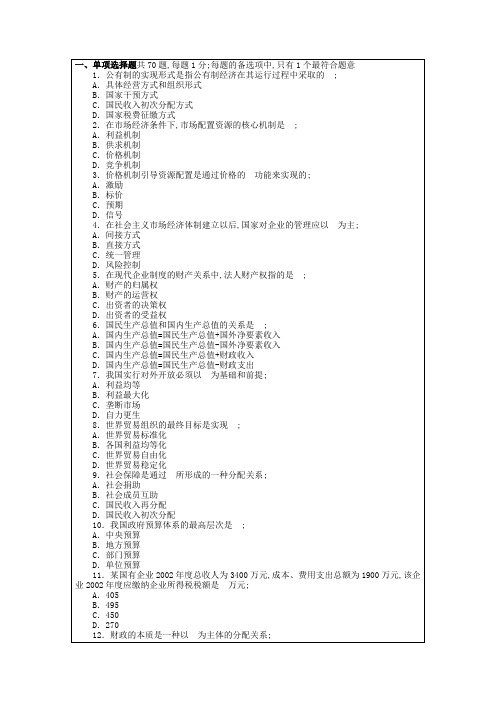

2025年经济师考试经济基础知识(初级)自测试卷(答案在后面)一、单项选择题(本大题有70小题,每小题1分,共70分)1、在经济学中,货币的供应量与需求量达到平衡时的状态被称为()。
A、通货膨胀B、通货紧缩C、货币均衡D、货币贬值2、以下哪项不是市场经济的基本特征()。
A、资源配置的市场化B、竞争机制C、政府干预D、私有制3、在经济学中,稀缺性指的是:A. 生产商品的技术不足B. 生产力不发达导致生产量不够C. 相对于人类无穷的欲望而言,资源总是有限的D. 市场上的商品供不应求4、下列哪一项属于宏观经济政策的目标?A. 实现充分就业和物价稳定B. 确保每个公民都有工作C. 消除贫富差距D. 使股票市场持续上涨5、在市场经济条件下,下列哪项不属于市场配置资源的基本方式?A、供求关系B、价格机制C、政府调控D、企业自主6、下列关于宏观调控的说法中,不正确的是:A、宏观调控是政府为了实现国家经济社会发展目标而采取的政策措施B、宏观调控主要通过财政政策和货币政策进行C、宏观调控的主要目标是保持经济的稳定增长D、宏观调控可以完全消除市场经济的波动7、下列关于宏观经济调控目标的说法,错误的是:A、稳定物价B、促进经济增长C、保持国际收支平衡D、提高社会福利水平8、在市场经济条件下,下列哪一项不是影响价格变动的因素?A、供求关系B、生产成本C、政府政策D、消费者心理9、下列哪一项不属于中央银行的主要职能?A. 发行货币B. 制定货币政策C. 监管商业银行D. 向企业提供贷款 10、在宏观经济政策目标中,充分就业是指:A. 所有劳动力都有工作B. 失业率等于自然失业率C. 没有人失业D. 政府提供了足够的工作岗位11、某企业计划投资1000万元用于购买设备,现有两个方案:方案A为立即购买,预计设备使用年限为5年,每年可节省成本200万元;方案B为分期付款,首期支付500万元,剩余500万元在3年内等额支付,设备使用年限为8年,每年可节省成本180万元。
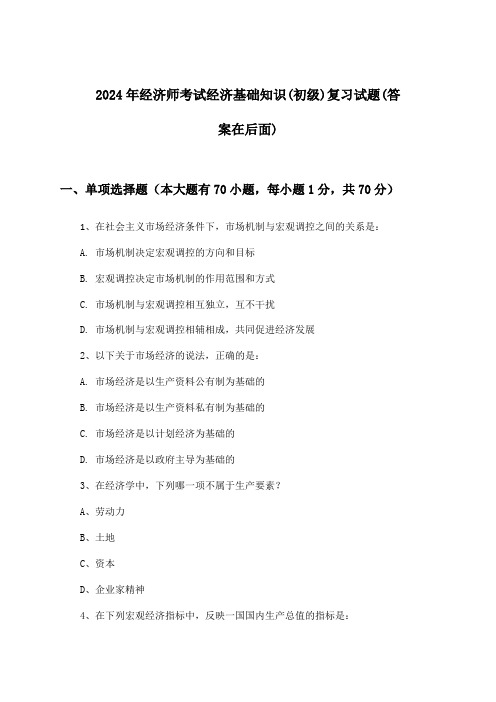
2024年经济师考试经济基础知识(初级)复习试题(答案在后面)一、单项选择题(本大题有70小题,每小题1分,共70分)1、在社会主义市场经济条件下,市场机制与宏观调控之间的关系是:A. 市场机制决定宏观调控的方向和目标B. 宏观调控决定市场机制的作用范围和方式C. 市场机制与宏观调控相互独立,互不干扰D. 市场机制与宏观调控相辅相成,共同促进经济发展2、以下关于市场经济的说法,正确的是:A. 市场经济是以生产资料公有制为基础的B. 市场经济是以生产资料私有制为基础的C. 市场经济是以计划经济为基础的D. 市场经济是以政府主导为基础的3、在经济学中,下列哪一项不属于生产要素?A、劳动力B、土地C、资本D、企业家精神4、在下列宏观经济指标中,反映一国国内生产总值的指标是:A、国民收入B、国内生产总值C、消费支出D、进口总额5、题目:在经济学中,以下哪个概念指的是一定时期内一个国家或地区生产的全部最终产品(包括物品和劳务)的市场价值?A. 国内生产总值(GDP)B. 国民总收入(GNI)C. 工农业总产值D. 工业增加值6、题目:以下哪项不属于货币政策的三大工具?A. 利率B. 财政政策C. 公开市场操作D. 预算赤字7、下列哪一项属于我国货币政策的中介目标?A. 利率水平B. 货币供应量C. 外汇储备D. 国内生产总值(GDP)8、根据凯恩斯主义理论,在短期内若总需求增加,则价格水平和产出将会如何变化?A. 价格水平上升,产出增加B. 价格水平下降,产出减少C. 价格水平不变,产出增加D. 价格水平上升,产出不变9、在市场经济条件下,以下哪项不是影响价格变动的直接因素?A. 供求关系B. 生产成本C. 国家政策D. 企业形象11、在经济学中,当边际成本等于边际收益时,厂商实现了利润最大化。
这一原则适用于哪种市场结构?A. 完全竞争市场B. 垄断竞争市场C. 寡头市场D. 所有市场结构13、下列关于通货膨胀的说法,不正确的是:A. 通货膨胀是指一般物价水平持续、普遍地上涨B. 通货膨胀会导致货币购买力下降C. 通货膨胀会导致实际利率下降D. 通货膨胀会导致失业率上升15、在经济学中,当边际成本(MC)低于平均总成本(ATC)时,对于平均总成本的影响是什么?A. 平均总成本上升B. 平均总成本下降C. 平均总成本不变D. 无法确定17、在市场经济条件下,决定商品价格的主要因素是:A. 政府的定价B. 商品的成本C. 市场的供求关系D. 消费者的购买力19、在市场经济条件下,以下哪项不属于资源配置的方式?()A. 价格机制B. 政府调控C. 竞争机制D. 情感机制21、在经济学中,以下哪一项属于固定成本?A. 原材料成本B. 工资成本C. 机器折旧D. 销售收入23、下列哪一项属于我国货币政策的中介目标?A、经济增长B、物价稳定C、货币供应量D、充分就业25、下列关于经济政策目标的说法,正确的是:A. 经济政策目标具有单一性,只能追求经济增长B. 经济政策目标具有全面性,追求经济增长、社会稳定、环境保护等多重目标C. 经济政策目标具有短期性,只关注当前的经济状况D. 经济政策目标具有滞后性,只能被动应对经济波动27、某企业在2020年实现营业收入1000万元,营业成本800万元,营业税金及附加50万元,期间费用100万元,利润总额为()万元。
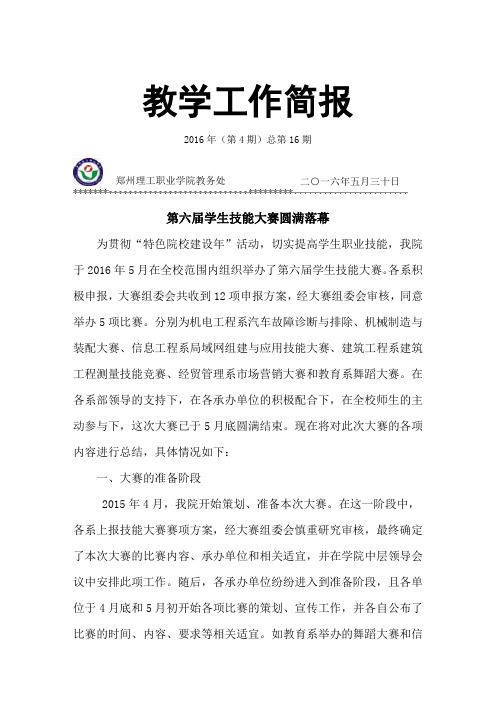
教学工作简报2016年(第4期)总第16期郑州理工职业学院教务处二○一六年五月三十日*******************************************************************第六届学生技能大赛圆满落幕为贯彻“特色院校建设年”活动,切实提高学生职业技能,我院于2016年5月在全校范围内组织举办了第六届学生技能大赛。
各系积极申报,大赛组委会共收到12项申报方案,经大赛组委会审核,同意举办5项比赛。
分别为机电工程系汽车故障诊断与排除、机械制造与装配大赛、信息工程系局域网组建与应用技能大赛、建筑工程系建筑工程测量技能竞赛、经贸管理系市场营销大赛和教育系舞蹈大赛。
在各系部领导的支持下,在各承办单位的积极配合下,在全校师生的主动参与下,这次大赛已于5月底圆满结束。
现在将对此次大赛的各项内容进行总结,具体情况如下:一、大赛的准备阶段2015年4月,我院开始策划、准备本次大赛。
在这一阶段中,各系上报技能大赛赛项方案,经大赛组委会慎重研究审核,最终确定了本次大赛的比赛内容、承办单位和相关适宜,并在学院中层领导会议中安排此项工作。
随后,各承办单位纷纷进入到准备阶段,且各单位于4月底和5月初开始各项比赛的策划、宣传工作,并各自公布了比赛的时间、内容、要求等相关适宜。
如教育系举办的舞蹈大赛和信息工程系举办的局域网组建与应用技能大赛,更是做出了精美的海报,全院张贴,使大赛深入每一个同学心中。
二、大赛的竞赛阶段经过第一阶段的充分准备后,各项比赛于2015年5月9日开始陆续进入到竞赛阶段,各承办单位依然按照计划有条理的工作,各项比赛也在全校师生的积极参与下如火如荼地进行着,还由于选手们的精心准备使得比赛更加精彩。
各项大赛根据自身特点,结合专业性质,与其相应课程相结合,成分体现核心知识及技能,充分体现了职业技能特点,提高了提高学生职业技能。
如汽车故障诊断与排除技能竞赛,与《汽车故障诊断与检测技术》课程项目化考核组成部分,成绩占期末考试的60%,信息工程系的局域网组建与应用技术技能大赛以赛代考,都改变了以往的试卷考试考试形式,以赛促考、以赛代考,充分调动了学生的学习积极性。
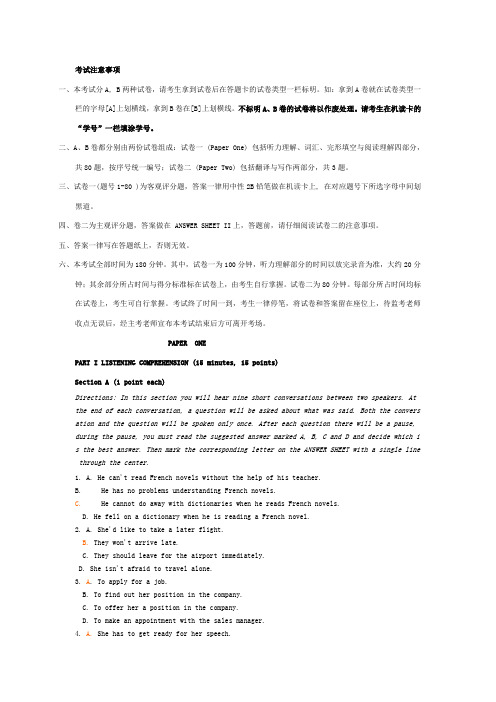
考试注意事项一、本考试分A, B两种试卷,请考生拿到试卷后在答题卡的试卷类型一栏标明。
如:拿到A卷就在试卷类型一栏的字母[A]上划横线,拿到B卷在[B]上划横线。
不标明A、B卷的试卷将以作废处理。
请考生在机读卡的“学号”一栏填涂学号。
二、A、B卷都分别由两份试卷组成:试卷一 (Paper One) 包括听力理解、词汇、完形填空与阅读理解四部分,共80题,按序号统一编号;试卷二 (Paper Two) 包括翻译与写作两部分,共3题。
三、试卷一(题号1-80 )为客观评分题,答案一律用中性2B铅笔做在机读卡上, 在对应题号下所选字母中间划黑道。
四、卷二为主观评分题,答案做在 ANSWER SHEET II上,答题前,请仔细阅读试卷二的注意事项。
五、答案一律写在答题纸上,否则无效。
六、本考试全部时间为180分钟。
其中,试卷一为100分钟,听力理解部分的时间以放完录音为准,大约20分钟;其余部分所占时间与得分标准标在试卷上,由考生自行掌握。
试卷二为80分钟。
每部分所占时间均标在试卷上,考生可自行掌握。
考试终了时间一到,考生一律停笔,将试卷和答案留在座位上,待监考老师收点无误后,经主考老师宣布本考试结束后方可离开考场。
PAPER ONEPART I LISTENING COMPREHENSION (15 minutes, 15 points)Section A (1 point each)Directions: In this section you will hear nine short conversations between two speakers. At the end of each conversation, a question will be asked about what was said. Both the convers ation and the question will be spoken only once. After each question there will be a pause, during the pause, you must read the suggested answer marked A, B, C and D and decide which i s the best answer. Then mark the corresponding letter on the ANSWER SHEET with a single line through the center.1. A. He can't read French novels without the help of his teacher.B. He has no problems understanding French novels.C. He cannot do away with dictionaries when he reads French novels.D. He fell on a dictionary when he is reading a French novel.2. A. She'd like to take a later flight.B. They won't arrive late.C. They should leave for the airport immediately.D. She isn't afraid to travel alone.3. A. To apply for a job.B. To find out her position in the company.C. To offer her a position in the company.D. To make an appointment with the sales manager.4. A. She has to get ready for her speech.B. She doesn't like sea food.C. She thinks the restaurant is too expensive.D. She will accompany the man to the restaurant.5. A. It's no longer of any use to her.B. She feels the man's apology is enough.C. It does have a back cover.D. She is a generous woman by nature.6. A. To a guest house.B. To the theater.C. To a hotel.D. To a restaurant.7. A. To remind him of the time for the film.B. To tell him she is busy.C. To ask him to go to the movies.D. To invite him to sing.8. A. He is curious.B .He is satisfied.C. He is exhausted.D. He is impatient.9. A. Looking for a job.B. Looking for an apartment.C. Taking a suburban excursion.D. Asking the man for his opinions.Section B (1 point each)Directions: In this section, you will hear two short passages. At the end of each passage, y ou will hear some questions. Both the passage and the question will be spoken only once. Aft er you hear one question, you must choose the answer from the four choices marked A, B, C and D. Then mark the corresponding letter on the ANSWER SHEET with a single line through the center.Questions 10~12 are based on the following passage:10. A. Intellectual challenge.B. Social challenge.C. Physical challengeD. Economic challenge.11. A. Building pyramids.B. Exploring the spaceC. Making plans for transportation.D. Painting a picture.12. A. They face them.B. They are interested in them.C. They accept and enjoy them.D. They ignore themQuestions 13 — 15 are based on the following passage:13. A. It's a new method to measure a country's production.B. It's a way to study the economies of different countries.C. It's a new system to help make economic decisions.D. It's a means to understand a country's economic changes.14. A. GDP does not include earnings of companies operating in foreign countries.B. GDP counts only goods and services produced within the nation's borders.C. GDP refers to earnings from home-made products.D. Earnings by foreign-owned companies are not included in GDP.15. A. Because economic experts generally approve GDP.B. Because most industrial countries used GDP.C. Because GDP provides a truer measure of a country's economy.D. Because GDP is easier to be understood.PART II VOCABULARY ( 15 minutes, 10 points)Section A (0.5 point each)Directions: In this section there are ten sentences, each with one word or phrase underlined.Choose the one from the four choices marked A, B, C and D that best keeps the meaning of the sentence. Then mark the corresponding letter on the ANSWER SHEET with a single line through the center.16. Reports of torture and mass execution in the concentration camps have outraged the worldreligious leaders.A. irritatedB. slashedC. ragedD. reminded17.Thousands of English words derive from Latin.A. obtainB. detectC. decodeD. originate18.I have always regarded him as a man of integrity.A. characterB. integrationC. kindnessD. uprightness19. What a tremendous party it's been! I have enjoyed every minute of it.A. humorousB. fortunateC. contentD. wonderful20. Jefferson believed in human rights. He approved of the French Revolution.A. joinedB. opposedC. devotedD. was in favor of21.People are understandably wary of the new government.A. gratefulB. hostileC. cautiousD. ironic22.She gave a cordial reception to her guest.A. welcomeB. partyC. invitationD. overcoat23. This is one of several extraordinary scenes in the movie, including the sudden murderof a young man that triggers the suppressed desire between George and Lucy.A. activatedB. wipedC. meddledD. posed24. William E. Boeing, founder of the company that designed the 747, had to resort to manufacturing bedroom furniture to survive some lean years.A. come toB. turn toC. add toD. apply to25. These changes have made the campus an easier place for people with handicaps.A. disabilitiesB. casualtiesC. obstaclesD. injuriesSection B (0.5 point each)Directions: In this section, there are ten incomplete sentences. For each sentence, the re are four choices marked A, B, C and D. Choose the one that best completes the sentence. T hen mark the corresponding letter on the ANSWER SHEET with a single line through the center.26. If you want to know the train schedule, please____________ ______ at the booking office.A. acquireB. inquireC. requestD.require27. One of the rumors____________ at the moment is that the company is about to go bankrupt.A. evaporatingB. circulatingC. emitting D. elaborating28. This candidate has an impressively__________ _____ range of interests and experience.A. diverseB. reverseC. adverse D. controversial29. China will continue to be the most__________ ______ economic region in Asia.A. effectiveB. intermediateC. practicalD.dynamic30. May I________ that if we don't leave now we shall miss the bus?A. point outB. pick outC. wipe outD.make out31. The patient condition has _______ since he had a heart attack.A. deterioratedB. decreaseC. treatedD.diagnosed32.The policeman stopped him when he was driving home and ______ him of speeding.A. chargedB. accusedC. blamedD. weary33.The poverty of some of the districts is an____________ _____ to good education.A. objectionB. obstacleC. obligation D. obsession34. It has become necessary to develop new and better tools of market research in order to _____sales with greater certainty because production and purchasing has to be adjusted to sales expectations.A. fosterB. forecastC. calculate D. promote35. In the past few years the workers have_____ a lot of suggestions, some of which are being put into practice.A. put downB. put offC. put ou tD. put forwardPART IV READING COMPREHENSION (60 minutes, 30 points)Directions: In this part of the test, there are five short passages for you to read. Read ea ch passage carefully, and hen do the questions that follow. Choose the best answer from the four choices marked A, B, C and D and then mark the corresponding letter on the ANSWER SHEET with a single line through the center.Passage 1Gopher Prairie, in which the action of Sinclair Lewis' Main Street (1920) takes place, isa town of 3, 000 inhabitants, smug, dull people whose one idea is to get on materially. They have no use for anyone who wishes something better for them; they oppose civic(市政的) r eform, cultural and educational projects. The most honored citizens are bankers. Carol, who has been to college and held a position as a librarian, comes to Gopher Prairie to live with her doctor husband. Appalled by the stagnant(停滞的) life of the town, and failing to bec ome adjusted to it, she tries a number of cultural ideas. Her efforts to establish a little theater meet with no encouragement. Indeed, the people merely think she is putting on airs.Her affection for her husband wanes(衰落), and she takes up with Erik Valborg, in whom she sees a spirit akin(类似的) to her own. She leaves the little town for Washington, D. C., w here she works as a government clerk. Later she returns to Gopher Prairie, better equipped t han before to understand the forces which shape Main Street.At the time of its first appearance, Main Street provoked a storm of protest on the grou nd that the novelist libeled(诽谤)good Americans. Today, no one thinks of repeating this c harge. Indeed, as Lewis Gannett points out, Main Street has in no way changed except externa lly; it is the same Main Street; yet, doubtless it reads Sinclair Lewis' novels as eagerly a s the rest of the nation. At the time when Main Street was published Lewis was accused of ha ting dull people. The novelist retorted that he did not hate them: he loved them. The truth is, the world of 1920 could not stand criticism. The Pulitzer Prize committee refused to awa rd Main Street a prize. The novelist was to have his revenge six years later, when he reject ed the same award for Arrowsmith .51. Which of the following is the central preoccupation of the people of Gopher Prairie?A. Progressive education.B. Material possessions.C. Cultural activity.D. Civic reform.52. When the people of Gopher Prairie thought that Carol was "putting on airs, " they meantthat she ______.A. talkativeB. pretentiousC. organizedD. overdressed53. In the first paragraph, Erik Valborg's spirit is said to be "akin" to Carol's, becausethey ______ .A. are related by marriageB. share a common religionC. have mutual interestsD. are emotional people54. According to the passage, why was there such adverse reaction to Main Street in 1920?A. People were reluctant to admit their faults.B. Sinclair Lewis did not like honorable citizens.C. Gopher Prairie was portrayed inaccurately.D. The main character led an unconventional life.55. According to the passage, which of the following statements best explains why SinclairLewis rejected the Pulitzer Prize for Arrowsmith?A. He thought Arrowsmith was not worthy of the honor.B. He disapproved of the composition of the Pulitzer Prize committee.C. He claimed that the Pulitzer Prize had no status.D. He felt the committee had unjustly overlooked his previous work.Passage 2It is all very well to blame traffic jams, the cost of petrol and the quick pace of mod ern life, but manners on the roads are becoming horrible. Everybody knows that the nicest me n become monsters behind the wheel. It is all very well, again, to have a tiger in the tank, but to have one in the driver's seat is another matter altogether. You might tolerate the o dd road-hog, the rude and inconsiderate driver, but nowadays the well-mannered motorist is the exception to the rule. Perhaps the situation calls for a "Be Kind to Other Drivers" camp aign, otherwise it may get completely out of hand.Road politeness is not only good manners, but good sense too. It takes the most cool-he aded and good-tempered of drivers to resist the temptation to revenge when subjected to unci vilized behavior. On the other hand, a little politeness goes a long way towards relieving t he tensions of motoring. A friendly nod or a wave of acknowledgement in response to an act of politeness helps to create an atmosphere of goodwill and tolerance so necessary in moderntraffic conditions. But such acknowledgements of politeness are all too rare today. Many dri vers nowadays don't even seem able to recognize politeness when they see it.However, misplaced politeness can also be dangerous. Typical examples are the driver wh o brakes violently to allow a car to emerge from a side street at some hazard to following t raffic, when a few seconds later the road would be clear anyway; or the man who waves a child across a zebra crossing into the path of oncoming vehicles that may be unable to stop in time. The same goes for encouraging old ladies to cross the road wherever and whenever they c are to. It always amazes me that the highways are not covered with the dead bodies of these grannies.A veteran driver, whose manners are faultless, told me it would help if motorists learnt to filter correctly into traffic streams one at a time without causing the total blockages that give rise to bad temper. Unfortunately, modern motorists can't even learn to drive, le t alone master the subtler aspects of roadsmanship. Years ago the experts warned us that thecar-ownership explosion would demand a lot more give-and-take from all road users. It is hi gh time for all of us to take this message to heart.56. According to the passage, troubles on the road are primarily caused by _____.A. people's attitude towards the road-hogB. the rhythm of modern lifeC. the behavior of the driverD. traffic conditions57. The sentence "You might tolerate the odd road-hog ... the rule. " (para. 1) implies that ________.A. our society is unjust towards well-mannered motoristsB. rude drivers can be met only occasionallyC. the well-mannered motorist cannot tolerate the road-hogD. nowadays impolite drivers constitute the majority of motorists58. By "good sense", the writer means__________ ______ .A. the driver's ability to understand and react reasonablyB. the driver's prompt response to difficult and severe conditionsC. the driver's tolerance of rude or even savage behaviorD. the driver's acknowledgement of politeness and regulations59. Experts have long pointed out that in the face of car-ownership explosion, ______.A. road users should make more sacrificeB. drivers should be ready to yield to each otherC. drivers should have more communication among themselvesD. drivers will suffer great loss if they pay no respect to others60. In the writer's opinion, ______.A. strict traffic regulations are badly neededB. drivers should apply road politeness properlyC. rude drivers should be punishedD. drivers should avoid traffic jamsPassage 3As a medium of exchange, money permits the separation of exchange into the two distinct ac ts of buying and selling, without requiring the seller to purchase goods from the person who buys his products, or vice versa(反之亦然). Hence, producers who know they will be paid in money, can concentrate on finding the most suitable outlet for their goods, while buyers who will pay in money, can concentrate on finding cheapest market for the things they wish t o purchase. Specialization, which is vital to an advanced economy, is encouraged, because pe ople whose output is not a complete product but only a part of one in which many others are involved can be paid an amount equivalent to their share of the product.Another advantage of money is that it is a measure of value — that is, it serves as a u nit in terms of which the relative values of different products can be expressed. In a barte r economy(物物交换经济) it would be necessary to determine how many plates were worth one hundred weight of cotton, or how many pens should be exchanged for a ton of coal, which would be a difficult and time-consuming task. The process of establishing relative values wouldhave to be undertaken for every act of exchange, according to what products were being offer ed against one another, and according to the two parties' desires and preferences. If I am trying to barter fish for bananas, for example, a lot would depend on whether the person will ing to exchange bananas is or is not keen on fish.Thirdly, money acts as a store of wealth. It is difficult to image saving under a barter system. No one engaged on only one stage in the manufacture of a product could save part of his output, since he would be producing nothing complete. Even when a person actually produ ced a complete product the difficulties would be overwhelming. Most products deteriorate fai rly rapidly, either physically or in value, as a result of long storage; even if storage wer e possible, the practice of storing products for years on would involve obvious disadvantage s — imagine a coal-miner attempting to save enough coal, which of course is his product, to keep him for life. If wealth could not be saved, or only with great difficulty, future need s could not be provided for, or capital accumulated to raise productivity.61. Using money as a medium of exchange means that______________ ______.A. you have to sell something in order to buy somethingB. you have to buy something in order to sell somethingC. you don't have to buy something in order to sell somethingD. the seller and the purchaser are the same person62. Specialization is encouraged because___________ _______.A. people can use their money to buy whatever they wantB. people do not need to make a complete product for exchangeC. people make a great contribution to the manufacture of a productD. people can not use their money to buy whatever they want63. A barter economy is one in which___________ _______.A. value is decided by weightB. value is decided by numberC. money is used and goods are not exchangedD. goods are exchanged and money is not used64. If one had to save products instead of money, _______.A. this would need years of practiceB. coal, for example, would lose its valueC. they could not be stored for years on endD. many products would lose their value65. How many advantages of money are mentioned in this passage?A. Two.B. Three.C. Four.D. Fiv e.Passage 4Kristina Mercier noticed her ten-year-old son, Brad, was becoming a nervous wreck(精神脆弱者)the closer it got to test day. A high school English teacher in Wilmington, North Ca rolina, says Brad was terrified he'd flunk(不及格) a state-mandated test(州统考). "He di dn't want to go to school and started crying about every little thing," she says. "For a whi le, he was even having nightmares. I thought I'd have to take him to a psychiatrist. Then I found out the school principal was getting on the intercom every morning and saying, ' I wan t you to work really hard today so you'll pass the test. ' Brad has always been a bit of a w orrier. He really took it to heart."The rise of standardized tests has had some unfortunate results. Now mandated(规定) by48 states, such tests are intended to raise standards, providing parents — and legislators— with a measuring stick of how well teachers are doing. School district budgets, teacher pay and bonuses(奖金), and student grade advancement are tied to test performance in a gro wing number of communities. As educators feel the heat, so do the kids — and some can't han dle it. "Kids see their teachers' anxiety over the tests and that makes them feel there's so mething to really worry about," says Leo Mickey Fenzel, Ph.D., associate professor of psycho logy at Loyola College in Maryland, and author of several studies on children's stress. "Eve n the best students get nervous because they're afraid they'll mess up and disappoint teache rs, parents, and themselves."Devin O'Leary of Bloomington, Indiana, had a full-fledged(全面的) meltdown(垮台), t hanks to his statewide third-grade test. "For weeks, teachers let the children know that thi s was a very serious test — the school had placed below the state average in the past, so e veryone was uptight(紧张的), " says Debby O'Leary, his mother. Then, on test day, Devin wa s scolded for leaving his chair to help another child who was whining(嘀咕) because he cou ldn't do the math problems. "Devin got hysterical(歇斯底里); he was crying and shaking so much he had to be sent to the principal's office, " she says. Although her son scored in the ninety-seventh percentile, Debby is relieved to know that he won't have another such test u ntil he's in the sixth grade.Ramirez Miller has seen kids cry, get sick to their stomachs, even wet their pants over such pressure. But she's found ways to ease the strain on the kids in her class. "We used t o give the tests cold turkey, but now we teach basic test skills, like how to fill out an an swer bubble, and give practice exams, so kids become comfortable with the questions, " she s ays. "I try to make the two weeks before the test very relaxed, because if I'm showing stres s, it will be transmitted to the children." The result? Relaxed children and higher scores.Which proves that, with some insight and creativity, school stress need not be a required pa rt of the curriculum.66. Which of the following applies to the description of Kristina Mercier's son after hisexamination?A. He was completely destroyed by the horrible stated-mandated test.B. He showed certain symptoms of nervous breakdown.C. He couldn't concentrate on doing things related to the exam.D. He was brought to the hospital for advice from a psychiatrist.67. What is the purpose of the increase of standardized tests in 48 states in the USA?A. To improve the standards of teaching and help offering a reference framework.B. To help raise the school region budgets, teacher's salary and his or her bonuses.C. To make the examination more complicated to be handled with by the students.D. To put both the teachers and students under certain pressure for further advancement.68. The first sentence in the third paragraph refers to that ______.A. Devin got a perfect mark in the state-mandated test when he was in the third gradeB. Devin melt a full cup of ice when he participated in his third grade test in the stateC. Devin was thoroughly destroyed in his mind because of his behavior in the testD. Devin was very grateful for the statewide test in that he fled from the meltdown69. What is the probable meaning of "cold turkey" in the last paragraph?A. A large, widely domesticated North American bird with cold body.B. An uncooked cold dish provided in the test like salad.C. A retarded child who acted like a dumb cold turkey.D. A sudden or unprepared administration of certain examination.70. What's the author's attitude towards the rise of American standardized tests?A. Approval.B. Objection.C. Objectivity.D. Indifference.Passage 5Whether the eyes are "the windows of the soul" is debatable; that they are intensely i mportant in interpersonal communication is a fact. During the first two months of a baby's l ife, the stimulus that produces a smile is a pair of eyes. The eyes need not be real: a mask with two dots will produce a smile. Significantly, a real human face with eyes covered will not motivate a smile, nor will the sight of only one eye when the face is presented in prof ile. This attraction to eyes as opposed to the nose or mouth continues as the baby matures.In one study, when American four-year-olds were asked to draw people, 75 percent of them dre w people with mouths, but 99 percent of them drew people with eyes. In Japan, however, where babies are carried on their mother's back, infants do not acquire as much attachment to eye s as they do in other cultures. As a result, Japanese adults make little use of the face eit her to encode or decode meaning. In fact, Argyle reveals that the "proper place to focus one 's gaze during a conversation in Japan is on the neck of one's conversation partner."The role of eye contact in a conversational exchange between two Americans is well defi ned: speakers make contact with the eyes of their listener for about one second, then glance away as they talk; in a few moments they re-establish eye contact with the listener or rea ssure themselves that their audience is still attentive, then shift their gaze away once more. Listeners, meanwhile, keep their eyes on the face of the speaker, allowing themselves toglance away only briefly. It is important that they be looking at the speaker at the precise moment when the speaker re-establishes eye contact: if they are not looking, the speaker a ssumes that they are disinterested and either will pause until eye contact is resumed or wil l terminate the conversation. Just how critical this eye maneuvering is to the maintenance of conversational flow becomes evident when two speakers are wearing dark glasses: there maybe a sort of traffic jam of words caused by interruption, false starts, and unpredictable pa uses.71. The author is convinced that the eyes are____________ ______ .A. of extreme importance in expressing feeling and exchanging ideasB. something through which one can see a person's inner worldC. of considerable significance in making conversations interestingD. something the value of which is largely a matter of long debate72. Babies will not be stimulated to smile by a person______________ _______ .A. whose front view is fully perceivedB. whose face is covered with a maskC. whose face is seen from the sideD. whose face is free of any covering73. According to the passage, the Japanese fix their gaze on their conversation partner's neck because _______.A. they don't like to keep their eyes on the face of the speakerB. they need not communicate through eye contactC. they don't think it polite to have eye contactD. they didn't have much opportunity to communicate through eye contact in babyhood74. According to the passage, a conversation between two Americans may break down due to ______A. one temporarily glancing away from the otherB. eye contact of more than one secondC. improperly-timed ceasing of eye contactD. constant adjustment of eye contact75. To keep a conversation flowing smoothly, it is better for the participants ______.A. not to wear dark spectaclesB. not to make any interruptionsC. not to glance away from each otherD. not to make unpredictable pausesPassage 6In the last half of 19th century “capital” and “labor” were enlarging and perfecting t heir rival organizations on modern lines. Many an old firm was replaced by a limited liabili ty company with a bureaucracy of salaried managers. The change met the technical requirement s of the new age by engaging a large professional element and prevented the decline in effic iency that so commonly spoiled the fortunes of family firms in the second and third generati on after the energetic founders. It was moreover a step away from individual initiative, tow ards collectivism and municipal and state-owned business. The railway companies, though stil l private business managed for the benefit of shareholders, were very unlike old family busi ness. At the same time the great municipalities went into business to supply lighting, trams and other services to the taxpayers.The growth of the limited liability company and municipal business had important conseque nces. Such large, impersonal manipulation of capital and industry greatly increased the numb ers and importance of shareholders as a class, an element in national life representing irre sponsible wealth detached from the land and the duties of the landowners; and almost equally detached from the responsible management of business. All through the 19th century, America, Africa, India, Australia and parts of Europe were being developed by British capital, and B ritish shareholders were thus enriched by the world’s movement towards industrialization. T owns like Bournmouth and Eastbourne sprang up to house large “comfortable” classes who had retired on their incomes, and who had no relation to the rest of the community except that of drawing dividends(红利)and occasionally attending a shareholders’ meeting to dictate their orders to the management. On the other hand “shareholding” meant leisure and freedom w hich was used by many of the Victorians for the highest purpose of a great civilization.The “shareholders” as such had no knowledge of the lives, thoughts or needs of the wo rkmen employed by the company in which he held shares, and his influence on the relations of capital and labor was not good. The paid manager acting for the company was in more direct relation with the men and their demands, but even he had seldom familiar personal knowledge of the workmen which the employer had often had under the more patriarchal system of the old family business. Indeed, the mere size of operations and the numbers of the workmen involved rendered such personal relations impossible. Fortunately, however, the increasing power an。
2007年经济专业技术资格《经济基础知识》考试试题2007年《经济基础知识》(中级)考试真题及答案2008-8-21【大中小】【打印】一、单项选择题(共70题,每题1分。
每题的备选项中,只有1个符合题意)1.任何一个社会都必须通过一定的方式把有限的资源合理配置到社会需要的各个领域中去,以实现资源的最优利用,这是由资源的()决定的A.独占性B.稀缺性C.无限性D.社会性「答案」B.2.我国目前在农村实行的家庭联产承包责任制度属于()。
A.劳动者个体所有制B.集体所有制C.混合听有制D.股份合作制「答案」B.3.在我国,实行最高限价属于政府对市场价格的()。
A.平衡措施B.引导措施C.紧急措施D.干预措施「答案」D.4.在其他条件不变的情况下,如果某产品需求价格弹性系数小于1,则当该产品价格提高时,()。
A.会使生产者的销售收入减少B.不会影响生产者的销售收入C.会使生产者的销售收入增加D.生产者的销售收入可能增加也可能减少「答案」C.5.机会成本是指当一种生产要素被用于生产某产品时所放弃的使用该生产要素在其他生产用途中所得到的()。
A.最高收入B.最低收入C.平均收入D.超额收入「答案」A.6.如果一国在一定时期内年均经济增长率为8%,劳动增长率为2%,资本增长率为4%,劳动产出弹性和资本产出弹性分别为0.75和0.25,根据索洛的余值法,在8%的经济增长率中,技术进步的贡献约为()。
A.2.0%B.2.5%C.5.5%D.1.0%「答案」C.7.完全竞争市场和垄断竞争市场的主要区别在于()A.生产者数量的多少B.产品是否具有差别性C.消费者数量的多少D.进入障碍的大小「答案」B.8.如果既定的配置状态能够在其他人福利水平不下降的情况下,通过资源重新配置使至少一个人的福利水平有所提高,这种资源重新配置被称为()。
A.一般均衡状态B.帕累托改进C.瓦尔拉斯均衡D.帕累托最优「答案」B.9.在现代企业制度中建立和完善企业资产所有者和企业经营者之间委托代理关系的核心是()。
A.构建企业资产所有者的有限财产制度B.构建有效的控制机制和约束机制C.建立法人财产制度D.建立自主经营、自负盈亏的经营管理体制「答案」B.10.某造纸厂在其生产过程中,向附近的河流排放了大量的污水,并因此导致了附近某粮食产量大幅度下降,但该厂却又不对附近种粮农民进行相应的赔偿。
这种现象通常被称为()。
A.生产的外部经济B.生产的外部不经济C.消费的外部经济D.消费的外部不经济「答案」B.11.按照收入法计算国内生产总值,其公式是()。
A.国内生产总值=工资十利润十间接税和企业转移支付十折旧十统计误差B.国内生产总值=工资十利息十租金十利润十折旧十统计误差C.国内生产总值=工资十利息十租金十利润十间接税和企业转移支付十统计误差D.国内生产总值=工资十利息十租金十利润十同接税和企业转移支付十折旧十统计误差「答案」D.12.如果C.表示消费、I表示投资、G表示政府购买、X表示出口、M表示进口,则按照支出法计算的国内生产总值(GDP)的公式是()。
A.GDP=C十I十G十XB.GDP=C十I十G-MC.GDP=C十I十G十(X十M)D.GDP=C十I十G十(X-M)「答案」D.13.当使用国内生产总值反映一个国家的经济发展规模时,国内生产总值的计算应采用()。
A.不变价格B.现行价格C.平均价格D.预期价格「答案」B.14.我国统计部门计算和公布的反映失业水平方面的指标是()。
A.城镇实际失业率B.城镇预期失业率C.城镇登记失业率D.城乡登记失业率「答案」C.15.在政府对进出口贸易的干预措施中,出口退税属于()。
A.直接出口补贴B.间接出口补贴C.直接进口限制D.间接范围限制「答案」B.16.下列活动中,不属于公共财政应发挥职能作用范围的活动是()。
A.防止传染病B.防震救灾C.生产电风扇D.发展义务教育「答案」C.17.市场经济条件下,按照充分发挥市场对资源配置基础性作用的要求;公共财政要以满足()为出发点和落脚点。
A.私营经济需要B.社会公共需要C.国有经济需要D.涉外经济需要「答案」B.18.下列财政支出分类方法中,能够使政府每一项支出的具体用途得到全面、具体、清晰反映的是()。
A.按政府职能分类B.按支出使用部门分类C.按支出经济分类D.按支出能否直接得到价值补偿分类「答案」C.19.根据英国经济学家皮考克和魏斯曼提出的"梯度渐进增长理论",在正常年份财政支出的最高限度是()。
A.社会财富总量B.财政支出需要C.公众可以容忍的税收负担D.政府举借债务规模「答案」C.20.在构建社会主义和谐社会的过程中,财政支出必须坚持以人为本,把更多财政资金投向()领域。
A.城市建设B.消费品生产C.公共服务D.通讯设施「答案」C.21.制约财政收入规模的根本性因素是()。
A.税率标准B.纳税人数量C.经济发展水平D.居民收入水平「答案」C.22.按照我国的分税制财政体制,下列选项中()不属于中央固定收入。
A. 铁路运输部缴纳的房产税收入B.国有商业银行总行缴纳的营业税收入C.国家邮政局上缴的利润D.省属企业缴纳的消费税收入「答案」A.23.在国债发行制度中,决定国债发行条件的关键是国债的()。
A.发行数额B.票面金额C.流动性D.发行方式「答案」D.24.财政管理体制的核心内容是政府间的()。
A.财政管理机构设置B.财政收支划分C.企业隶属关系划分D.税权划分「答案」B.25.将财政政策分为扩张性政策、紧缩性政策和中性政策,这是根据()对财政政策进行的分类。
A.作用空间B.作用时间C.调节经济周期的作用D.调节经跻总量和结构的功能「答案」D.26.财政政策和货币政策协调配合的"双紧"类型,适合于()时采用。
A.经济中出现严重通货紧缩B.经济中出现严重通货膨胀C.保持经济适度增长的同时尽可能地避免通货膨胀D.控制通货膨胀的同时保持适度的经济增长「答案」B.27.提高存款准备金率对货币供求的影响是()。
A.增加货币需求B.减少货币需求C.增加货币供给D.减少货币供给「答案」D.28.从理论上讲,工资上涨过快容易导致()通货膨胀。
A.需求拉上型B.成本推进型C.输入型D.结构型「答案」B.29.中央银行对不动产以外的各种耐用,消费品的销售融资予以控制,这种货币政策具是()。
A.生产者信用控制B.商业信用控制C.证券市场信用控制D.消费者信用控制「答案」D.30.下列各项中,应填列于中央银行资产负债表中负债方的是()。
A.外汇储备B.流通中的通货C.贴现及放款D.政府债券「答案」B.31.下列各项中,不属于2003年《新巴塞尔资本协议》中"三大支柱"的是()。
A.最低资本要求B.市场约束C.综合监管D.监管当局的监督检查「答案」C.32.根据芝加哥大学教授法玛对有效市场的分类,如果有关证券的历史资料对证券的价格变动没有任何影响,则证券市场达到()。
A.零效率B.弱型效率C.半强型效率D.强型效率「答案」B.33.某甲与所供职的公司签订合同,该合同规定:某甲每月支付l00元,当其在公司工作满三年后,从第四年起有权按约定价格购买该公司一定数量的股票,这种交易是()交易。
A.金融期权B.金融期货C.投资基金D.货币掉期「答案」A.34.监管是政府对公众要求纠正某些社会个体和社会组织的不公平、不公正和无效率或低效率的一种回应。
这种理论属于金融监管理论中的()。
A.金融风险控制论B.信息不对称论C.保护债权论D.公共利益论「答案」D.35.巴塞尔协议规定银行的核心资本比率不得低于()。
A.4%B.6%C.8%D.10%「答案」A.36.若不考虑其它因素,人民币汇率升值对净出口的影响是()。
A.出口增加,进口减少B.出口减少,进口增加C.出口增加,进口增加D.出口减少,进口减少「答案」B.37.某公司在海外的子公司汇回投资利润,这应该记入国际收支平衡表中的()。
A.经常账户B.资本账户C.金融账户D.储备账户「答案」A.38.下列集中趋势中,适用于品质数据的是()。
A.众数B.简单算数平均数C.标准差D.加权算术平均数「答案」A.39.将学生成绩分为优、良、中、及格和不及格五类,所采用的计量尺度是()。
A.定比尺度B.定类尺度C.定序尺度D.定距尺度「答案」C.40.统计指标按其所反映的内容或其数值表现形式,可以分为总量指标、相对指标和()。
A.比例指标B.比率指标C.平均指标D.变异指标「答案」C.41.计算我国国内生产总值中的第一、二、三产业产值之比,是采用了计算()的数据整理方法。
A.比例B.均值C.比率D.百分比「答案」C.42.对一组数据进行分组,各组的组限依次是"10~20"、"20~30"、"30~40"、"40~50"、"50~60"、"60~70".在以上这组数据中,50这一数值()。
A.由于恰好等于组限,不需要分在某一组中B.分在"50~60"一组中C.分在"40~50"一组中D.分在"40~50"或"50~60"任意一组中都可以「答案」B.43.以2000年为基期,我国2002、2003年广义货币供应量的定基发展速度分别是137.4%和164.3%,则2003年与2002年相比的环比速度发展是()。
A.16.4%B.19.6%C.26.9%D.119.6%「答案」D.44.某连锁超市6个分店的职工人数有小到大排序后为57人、58人、58人、60人、63人、70人、其算术平均数、众数分别为()。
A.59、58B.61、58C.61、59D.61、70「答案」B.45.狭义的讲,指数是用于测定多个项目在不同场合下综合变动的一种特殊()。
A.算术平均数B.相对数C.总量指标D.几何平均数「答案」B.46.平均增长量是时间序列中()的序时平均数。
A.累计增长量B.报告期水平与某一固定时期水平(通常是时间序列最初水平)之差C.逐期增长量D.报告期发展水平「答案」C.47.已知某地区2002-2006年社会消费品零售总额的环比增长速度分别为4%、6%、9%、10%,则这一时期该地区社会消费品零售总额的定基增长速度为()。
A.4%×6%×9%×l0%B.(4%×6%×9%×l0%)+1C.(104%×106%×109%×l10%)-1D.104%×l06%× 109%×l10%「答案」C.48.对于一元线性回归方程确定,确定a、b的方法是()。